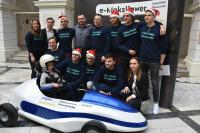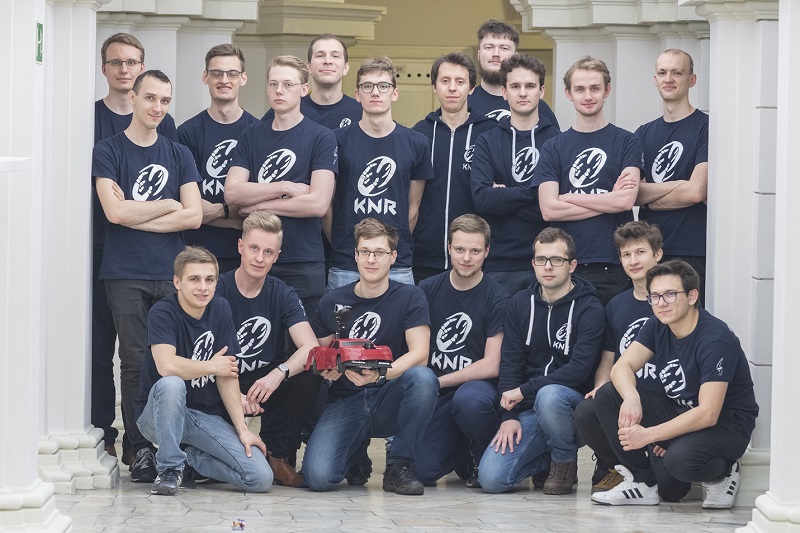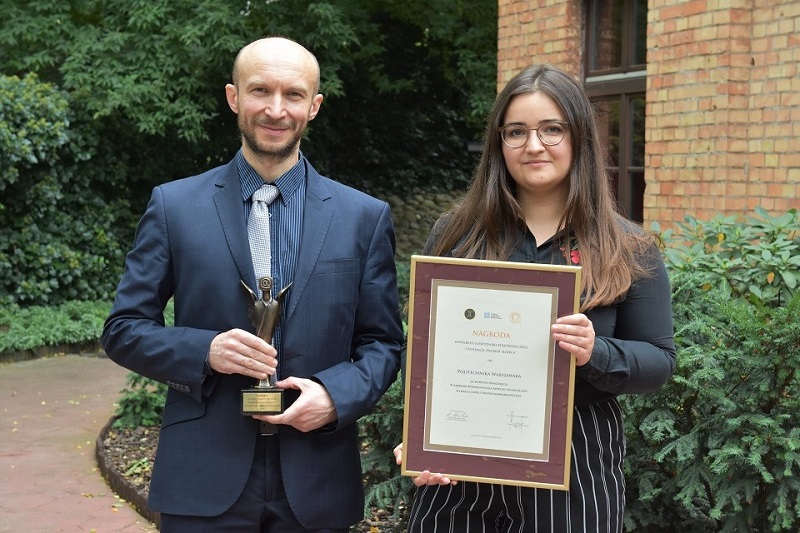It has been a year since the premiere of the e-vehicle built for Maks
It was a very special day – On 6 December 2019 the Main Building of the Warsaw University of Technology hosted the premiere of e-MaksPower, a vehicle built by our students for a 10 year-old automobile fan suffering from muscle atrophy. How has the project evolved and where are now the people involved in the events that took place one year ago? We did some digging.
What is e-MaksPower and what was its premiere like? Let's relive it!
Maks
Maks Młodawski, for whom the vehicle was designed, says that e-MaksPower is doing very well. “It’s great to drive it,” he says. “What I like the most is that it is faster than a wheelchair and it lets me pursue my passion for automobiles. I initially drove it quite often, but all our plans were derailed by the pandemic. Sadly, I did not have the opportunity to venture out into a race track, but I could train at the WUT car park.
Maks focuses on more than just his vehicle. He admits that he has been pursuing his hobby by watching car racing events and feature films about automobiles.
The designers
Work on the vehicle brought together students from four of the university’s student research groups, including the Students’ Research Group for Vehicle Aerodynamics, Robotics Research Group (both groups operate at the Faculty of Power and Aeronautical Engineering), ADek Research Group (operating at the Faculty of Electrical Engineering) and Inter-Faculty SmartCity Research Group (operating at the Faculty of Civil Engineering). They all handled the engineering work. Rafał Tomczak from the Academy of Fine Arts in Warsaw was in charge of graphic design.
About 30 people were involved in the project at its different stages. Some of them have since graduated from WUT and are now pursuing their own research and professional careers. Some wrote their diploma theses based on their contribution to the construction of e-MaksPower.
The project helped the designers to gain precious skills and experience which they went on to use in other projects.
“Long-term group work, being featured in TV shows and participation in electro-mobility fairs have all boosted my soft and interpersonal skills,” says Hubert Graczyk, a student of Applied Automation and Robotics at the Faculty of Electrical Engineering, who was in charge of the e-MaksPower control system and onboard computer.
“The experience related to the project had a definite strong impact on my life, not only personally, but also in professional and scientific terms,” Hubert adds. “Together with a colleague who also worked on the vehicle, we became coordinators of the OKOŃ autonomous robotic submarine of the Robotics Student Research Group. We can boast several successful achievements as part of the project, such as winning the KOKOS award in the Smart Robots category or qualifying for the international Singapore AUV Challenge and MATE Turkey Regional ROV Competition. Thanks to e-MaksPower, finding a job was a walk in the park all through my university years.
Hubert has a professional track record including paid internships and project cooperation at the international company FESTO SP z o.o. operating in the field of robotics and industrial automation, as well as a stint at VersaBox SP z o.o., which designs and manufactures state-of-the-art autonomous robots to work at warehouses and industrial halls.
“I currently work as Junior Electronic Engineer at the Łukasiewicz Research Network – Institute of Aviation,” says Hubert. “I work at the Centre of Space Technologies, at a department which develops rocket technologies”.
“Designing the steering system for the vehicle gave me the necessary experience to get my first job in my field of specialty,” thinks Piotr Saffarini, a graduate of the Mechatronics Department, who is currently studying Autonomous Systems at the Technical University of Denmark (DTU). “Documentation of the project in the form of a smoothly written engineering thesis was a great reward for long hours spent at the workshop. Joining the e-MaksPower team was the best thing that happened to me at university”.
The vehicle
Students from the Robotics Student Research Group decided to use e-MaksPower to test... autonomous driving. A WUT Driverless team was created in the Club to prepare for the international Indy Autonomous Challenge.
To qualify for the race, participants needed to prove that they had the knowledge and skills necessary to create an autonomous driving system for a vehicle capable of carrying passengers.
“The vehicle we were offered, e-MaksPower, turned out to be the perfect solution as a fully functional electric vehicle which we could work with without spending too much money or time,” says Marcel Kaliński, an Automation and Robotics major at the Faculty of Electronics and Information Technology.
For a regular man-driven vehicle (such as Maks’s vehicle) to become autonomous, it must be fitted with several additional elements.
“First of all, you need diverse sensors to enable the vehicle to analyze its environment,” Marcel explains. “Once data from the sensors are processed, the onboard computer decides where to go to ensure safety, speed and compliance with valid regulations. It ultimately generates the right steering signals to control the drive train and steering system to follow a trajectory as accurately as possible.
The students introduced slight modifications to e-Maks Power, fitting it with an onboard computer and a set of sensors. Next, they started working on the software. “We tapped into the experience gained when creating similar solutions to be used in small-scale driverless car races under the Selfie project,” says Marcel.
As you can see, the designers of the unique vehicle have passion and plans in spades. But there is more...
“After the premiere, we started working on other vehicles and organizing a champions’ league for Maks and his friends,” reveals Łukasz Krawczuk, AKA Walczuk, e-Maks Power project manager and graduate of the Faculty of Electrical Engineering. “Sadly, this venture was interrupted by COVID-19, but it continues to be our dream. I also know that one of our team members is working on an innovative product. I cannot reveal the details yet. I hope that we will all soon be able to appreciate his idea.”
The University
e-MaksPower has become the flagship project for Warsaw University of Technology and a showcase of our students’ skills.
“Working in an interdisciplinary team, such as the one required for this project, is not easy,” says dr hab. inż. Janusz Walo, WUT Professor, who followed the development of the project from day one as WUT Vice-Rector for Student Affairs between 2016 and 2020. “I have always been full of admiration for the designers of the vehicle, their passion, resolve and skills. It is quite edifying that our students decided to use their knowledge and free time to take on this engineering challenge and try to help a sick boy fulfil his dream.
The project turned out to be an engineering, media and promotional success. The interest evoked by e-MaksPower exceeded our expectations. After the first news about the idea was published and later, at the time of the premiere, all major Polish media, including TV and radio stations, newspapers and websites, reported extensively on the vehicle. Social media were full of posts about Maks’s vehicle. Even English-speaking reports were published.
The vehicle also won the main prize in the Life Upgrade category of the KOKOS competition and was one of the arguments in favor of the Warsaw University of Technology being granted the Award of the Electronic Economy Congress and of the "Promyk Słońca” Foundation. The promotion of e-MaksPower won the Genius Universitatis and PROMyk competitions. The project was also appreciated by the jury of the Klub Twórców Reklamy competition, who nominated it in the Technology category.











